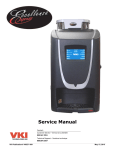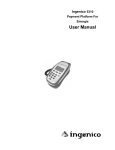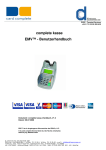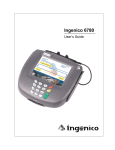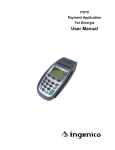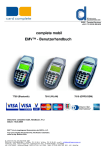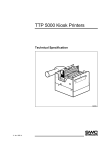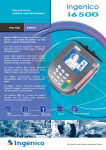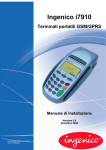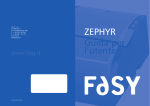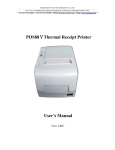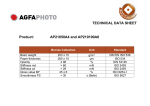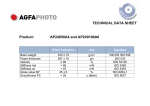Download Ingenico I7910 User's Manual
Transcript
• OPTIONAL LinkBox and ComBox MODULES To charge the battery: • Make sure battery pack is properly seated in i7910. • Plug the power adapter into the wall outlet and into the power connector at the back of i7910 terminal. contacts on the battery and on the terminal with a damp cloth Do not scratch or scrape the surface of the contacts. • If the print quality deteriorates, clean the print head to remove accumulated paper dust. The print head must be cleaned with the terminal powered off, using ethanol applied on a lint-free cloth. Be aware of the sharp paper cutter and hot printer parts. Ensure that the ethanol has completely evaporated before switching the terminal back on. These modules provide additional connections: Use the power adapter supplied with i7910. Many adapters can appear similar and will plug into i7910 but will not work properly causing erratic behavior, poor charging or damage to the unit. The i7910 with a fully charged battery can perform up to 200 transactions (depending of the ticket size, transaction duration, time between transactions and backlight usage). LinkBox provides a back-up dial connection (asynchronous and synchronous, V22bis or V34) and powered RS-232 port. ComBox provides two RS-232 ports, one of them powered (port marked RS232-2 provides power for the attached device). The battery status is updated on the i7910 display (the indicator depends of the application running on i7910): 1 bar represents 25 % of full capacity, 2 bars represent 50 % of full capacity, 3 bars represent 75 % of full capacity, 4 bars represent full capacity. - Connect LinkBox or ComBox to the i7910 RS-232 port, the letters “TOP” on a connector must be facing up. The green light (LinkBox only) indicates modem is ready. The light becomes red while dial connection is used. Connecting LinkBox to a telephone line: Plug the one end of a telephone cable into the port marked , and plug the other end of a telephone cable into a wall telephone jack. Attaching device to LinkBox or ComBox RS-232 port: Connect the serial cable to the RS-232 port. Plug the other end of the serial cable to the device (PC, ECR, bar code or check reader etc.). Do not short-circuit batteries. Do not open or alter batteries’ outside structure. Do not expose battery to fire, do not heat it. Do not expose battery to liquid, do not freeze it. Store batteries at 40% charge level in a cool and dry area. The recommended storage temperature is 15°C (59°F). Re-charge them to 40% every 3 to 4 months. 3.5. Connections: Turn the terminal off before connecting peripherals. 4. Power supply connector Depending of the application installed in the terminal, i7910 displays icons indicating: • battery charge level, • charging status and • received signal strength. Depending of the application, the i7910 terminal powers down after a period of inactivity (in order to prolong battery life). Pressing the green <OK> key powers i7910 back on. The i7910 with a fully charged battery can perform up to 200 transactions (depending of the ticket size, transaction duration, time between transactions and backlight usage). RS-2332 port • PERIPHERAL CONNECTION Connect the serial cable to the RS-232 port. Plug the other end of the serial cable to the device (PC, bar code or check reader etc.). For detailed instructions, ask the equipment supplier. • POWER CONNECTION Plug the power adapter radial jack into power supply connector at the back of i7910. Plug the power adapter into the wall outlet. The power supply: INPUT................................ 100-240 VAC, 50-60Hz OUTPUT............................................... 18VDC, 1A Normal Operation: 5. Cleaning procedure: • The i7910 must be off for all cleaning operations. • Do not clean the i7910 with water but with a dry or only 6. If you experience problems: HELP DESK NUMBER: 1-888-900-8221 CUSTOMER SERVICE CENTERS: In Canada: In the USA: 6520 Gottardo Court 6195 Shiloh Road, Suite D Mississauga, Ontario, L5T 2A2 Alpharetta, Georgia 30005 1-888-900-8221 (905-795-8221) 1-800-252-1140 (678-456-1200) This equipment has been tested and found to comply with the limits for a Class B digital device, pursuant to Part 15 of the FCC Rules. These limits are designed to provide reasonable protection against harmful interference in a residential installation. This equipment generates, uses and can radiate radio frequency energy and, if not installed and used in accordance with the instructions, may cause harmful interference to radio communications. However, there is no guarantee that interference will not occur in a particular installation. If this equipment does cause harmful interference to radio or television reception, which can be determined by turning the equipment off and on, the user is encouraged to try to correct the interference by one or more of the following measures: . Reorient or relocate the receiving antenna. . Increase the separation between the equipment and receiver. . Connect the equipment into an outlet on a circuit different from that to which the receiver is connected. . Consult the dealer or an experienced radio/TV technician for help. Changes or modifications not expressly approved by Ingenico could void the user’s authority to operate the equipment. Canadian Department of Communications (DOC) Warnings: This digital apparatus does not exceed the Class B limits for radio noise emissions from the digital apparatus as set out in the radio interference regulations of the Canadian Department of Communications. RF Exposure Warning: This unit has been shown to be capable of compliance for localized specific absorption rate (SAR) for uncontrolled environment/general population exposure limits specified in ANSI/IEEE Std. C95.1-1992 and had been tested in accordance with the measurement procedures specified in FCC/OET Bulletin 65 Supplement C (2001) and IEEE Std. 1528-200X (Draft 6.5, January 2002). This device and its antenna must not be co-located or operating with any other antenna or transmitter except Grant condition. Users are not permitted to modify this transmitter device. Any unauthorized change made to this device could void your authority to operate this device. For body worn operation, to maintain compliance with FCC RF exposure guidelines, use only accessories that contain no metallic components and provide a separation distance of 15mm (0.6 inches) to the body. Use of other accessories may violate FCC RF exposure guidelines and should be avoided. Ministry of Health (Canada), Safety Code 6. The standards include a substantial safety margin designed to assure the safety of all persons, regardless of age and health. The exposure standard for wireless mobile phones employs a unit of measurement known as the Specific Absorption Rate, or SAR. The SAR limit set by the FCC is 1.6W/kg *. * In the U.S. and Canada, the SAR limit for mobile terminals used by the public is 1.6 watts/kg (W/kg) averaged over one gram of tissue. The standard incorporates a substantial margin of safety to give additional protection for the public and to account for any variations in measurements. Ingenico Inc. 6195 Shiloh Road, Suite D, Alpharetta, Georgia 30005 Tel: (678) 456 – 1200 Fax: (678) 456 – 1201 i7910 GPRS Installation Guide www.ingenico-us.com Ingenico Canada Ltd. 79 Torbarrie Road, Toronto, Ontario, Canada, M3L 1G5 Tel: (416) 245 – 6700 Fax: (416) 245 – 6701 www.ingenico-ca.com slightly damp cloth. • Do not use solvent, detergent or abrasive products. If the terminal has battery charging problem, clean the DIV450006A 1. The magnetic stripe on the card has to face down and point toward the keypad. The card has to be swiped at uniform speed and pressure, ensuring that the card remains in contact with the bottom of the track throughout the entire swipe action. Ingenico 7910 description: The i7910 is an indoor, long range wireless GSM/GPRS point of sale electronic payment terminal designed to process debit, credit and smart card purchases. It is highly secured, EMV level 1 and 2 certified. The i7910 provides fast service, long life battery, convenience, flexibility and security powered by Ingenico’s High Security Core and UNICAPT™. It includes large graphic display and easy loading printer. Various peripherals can be connected to i7910 through its RS-232 port. Optional LinkBox offers back-up connection via dial modem. Printer Insert the smart card horizontally into the slot on the front of the i7910, the microchip facing up, and leave it in the reader throughout the transaction. The i7910 has EMV level 1&2 approvals and complies with the ISO 7816, Sync and Async T=1 & T=0. 1.5. Printer: The i7910 integrates a quiet, high speed, “easy-load” style thermal printer with graphics capability. 1.6. Battery: Rechargeable and easily replaceable Li-Ion battery pack. 1.7. SIM/SAM Card Connectors: Paper Feed Key Two card connectors are located on the bottom of the i7910. The SAM (Secure Access Module) supports smart card chips necessary for applications such as loyalty. 2. CANCEL Key 1. 2. 3. 4. 5. 6. CORR Key Smart Card Reader ENTER Key 1.2. Keypad: 18 keys, with a back light. The special function keys are: • Programmable function keys <F1>, <F2> and <F3> for navigation and access to various i7910 functions and the system and application menus. • Paper Feed key is used for a printer paper feed (a few cm). • The green <ENTER> key confirms the data entered or displayed. It also powers on the i7910. • The red <CAN> key cancels the current function and returns the terminal to the idle state. It also powers off the i7910 if it is not connected to the power supply (it depends of the application running on i7910). • The yellow <CORR> key corrects invalid data entry. • The blue <ADMIN> key is used to access the terminal administration function menu. 1.3. Magnetic Stripe Card Reader: The i7910 features a bi-directional, 3-track reader located on the right-hand side. The card can be swiped from the bottom to the top, or from the top to the bottom. i7910 terminal with Li-Ion battery pack. Thermal printer paper, one roll. Power supply for battery charging. LinkBox and phone cable (optional). ComBox (optional). This installation guide. Optional accessories for battery charging in a vehicle are available: Cigarette lighter adapter and power cable for a direct connection to car battery are also available. 1.1. Display: A 4 line x 16 character LCD graphic display, with a backlight. Ingenico 7910 Packaging Content: 3. i7910 Installation: i7910 is an indoor, long range wireless terminal powered up by rechargeable lithium – ion battery. Before terminal can be used, the SIM card and paper roll have to be installed and the battery has to be fully charged. 3. Close the cover, press it until it snaps. Power up the unit and press the blue “Paper feed” key to verify that paper feeds properly. Thermal Paper Specification: • Single ply thermal sensitive – POS or facsimile grade. • Basis Weight: (lb/rm 17 ins. X 22 ins. - 500) --- 14.5 ± 5% (GSM) --- 55 ± 5% • Caliper.............................2.4 ± 0.2 Mils or 60 ± 5 Microns • Brightness ...........................................................Min. 85% • Smoothness (Bekk Minimum) ................................... 300 s • Roll Width....................2.28 ± 0.040 in (58 mm ± 1.0 mm) • Roll Diameter........................... 1.97 in (50 mm) maximum • Roll Core ID.............................. 0.500 in (13 mm) nominal • Roll Core OD ............................ 0.625 in (16 mm) nominal Recommended brands: KANZAN............... KF50 KOEHLER.... KT55HS01 JUJO ..............AF50KS-E MITSUBISHI ....... P6402 Thermal paper should NOT be exposed to vinyl, plastics, adhesives, shrink-wraps, wet-toner copies or certain carbon papers, office light UV light, high humidity and temperature (above 65%, 25°C or 77°F) for long periods of time. 3.2. Installing the Battery Hold the battery as shown, connectors facing downwards. Do not touch connectors on the battery or on the i7910. Operating temperature ................................ +5°C to +40°C Humidity ........................ 20% to 90% without condensation Storage temperature..................................... -10°C to +60°C SIM card connector • • • • Unlock the SIM connector by sliding the metallic latch in the direction of the OPEN arrow. Lift the SIM cover upward and insert the SIM card. Swing the cover down and slide the latch into locked position (the LOCK arrow). Put the battery back in the i7910 handheld. To remove SIM card - remove battery, unlock the SIM connector, lift the cover and remove the card. 3.4. Charging the Battery: The i7910 comes with rechargeable lithium-ion battery. Only use the battery supplied with your terminal. Make sure that i7910 is turned off and that power supply is disconnected before handling the battery pack. Do not touch the contacts on the battery pack or on the i7910. Do not remove battery from i7910 unless installing or removing SIM card. Always charge battery at temperatures between 0° and 45°C. It is important to perform the full battery charge before using i7910 for the first time – charge the battery without interruptions until i7910 terminal indicates the end of charging process (no moving bars on the battery status icon). 3.1. Installing/Replacing the Printer Paper When the colored stripe on the paper appears, replace the paper: Turn OFF the i7910 before replacing paper roll. DO NOT touch the printer parts, they can be very hot. Be aware of the sharp paper cutter. 1. Push the button on the paper compartment cover toward the back and lift the cover. 2. Remove the empty paper roll and insert the new roll. Ensure that the paper is protruding from 3.3. Installing the SIM Card Two card connectors are located underneath the battery. The SIM card connector is the white one. Make sure that i7910 is turned off and that power supply is disconnected before handling the battery pack. Do not touch the contacts on the battery pack or on the i7910. • Remove the battery pack. 1.4. Smart Card Reader: Navigation keys Magnetic Stripe Card Reader UNDERNEATH the paper roll: Insert the two plastic teeth in the gaps on the i7910 case, place the battery into the cavity and push it. Press the battery handle until a click is heard. To prolong battery life: - Avoid frequent full discharges. Shallow (partial) discharges and often charges are preferred. Full discharge and charge is recommended after every 30-40 short charge/discharge cycles. - Protect batteries from high temperatures (for example, avoid leaving them in a vehicle on a hot summer day).


